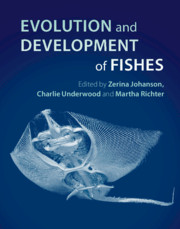Book contents
- Evolution and Development of Fishes
- Evolution and Development of Fishes
- Copyright page
- Contents
- Contributors
- Introduction
- 1 The Evolution of Fishes through Geological Time
- 2 Comparative Development of Cyclostomes
- 3 The Ordovician Enigma
- 4 The Evolution of Vertebrate Dermal Jaw Bones in the Light of Maxillate Placoderms
- 5 Doliodus and Pucapampellids
- 6 The Evolution of Endoskeletal Mineralisation in Chondrichthyan Fish
- 7 Plasticity and Variation of Skeletal Cells and Tissues and the Evolutionary Development of Actinopterygian Fishes
- 8 Origin, Development and Evolution of the Fish Skull
- 9 Evolution, Development and Regeneration of Fish Dentitions
- 10 Development of Head Muscles in Fishes and Notes on Phylogeny-Ontogeny Links
- 11 Evolutionary Development of the Postcranial and Appendicular Skeleton in Fishes
- 12 Evolution of Vertebrate Reproduction
- 13 Links between Thyroid Hormone Alterations and Developmental Changes in the Evolution of the Weberian Apparatus
- 14 Pharyngeal Remodelling in Vertebrate Evolution
- 15 Evolution of Air Breathing and Lung Distribution among Fossil Fishes
- Index
- References
14 - Pharyngeal Remodelling in Vertebrate Evolution
Published online by Cambridge University Press: 31 December 2018
- Evolution and Development of Fishes
- Evolution and Development of Fishes
- Copyright page
- Contents
- Contributors
- Introduction
- 1 The Evolution of Fishes through Geological Time
- 2 Comparative Development of Cyclostomes
- 3 The Ordovician Enigma
- 4 The Evolution of Vertebrate Dermal Jaw Bones in the Light of Maxillate Placoderms
- 5 Doliodus and Pucapampellids
- 6 The Evolution of Endoskeletal Mineralisation in Chondrichthyan Fish
- 7 Plasticity and Variation of Skeletal Cells and Tissues and the Evolutionary Development of Actinopterygian Fishes
- 8 Origin, Development and Evolution of the Fish Skull
- 9 Evolution, Development and Regeneration of Fish Dentitions
- 10 Development of Head Muscles in Fishes and Notes on Phylogeny-Ontogeny Links
- 11 Evolutionary Development of the Postcranial and Appendicular Skeleton in Fishes
- 12 Evolution of Vertebrate Reproduction
- 13 Links between Thyroid Hormone Alterations and Developmental Changes in the Evolution of the Weberian Apparatus
- 14 Pharyngeal Remodelling in Vertebrate Evolution
- 15 Evolution of Air Breathing and Lung Distribution among Fossil Fishes
- Index
- References
Summary
The pharynx is an important and intricate region of the body that has its developmental origin in a series of bulges found on the lateral surface of the embryonic head, the pharyngeal arches and these are a defining feature of vertebrate embryos. However, during evolution, the pharynx has also undergone extensive modifications, and these are particularly marked at three key transitions: the emergence of the vertebrates, the gnathostomes and the tetrapods. At each of these junctures the pharynx was extensively remodelled and mechanistic insights into how this was achieved can be gleaned from comparative analyses of pharyngeal development. In this chapter, we discuss the complex development of the pharynx. We consider the commonalities and differences between the pharyngeal region of vertebrates and other deuterostomes. We highlight the importance of early developmental events in the pharyngeal endoderm for laying down the fundamental organisation of this region, including the number of segments formed. Finally, we consider how the remodelling of the pharynx and the loss of pharyngeal segmentation from the adult form was achieved with the tetrapods. Overall, in this chapter we highlight the conserved and derived aspects of pharyngeal development and how these underpin the anatomy of this region.
- Type
- Chapter
- Information
- Evolution and Development of Fishes , pp. 241 - 251Publisher: Cambridge University PressPrint publication year: 2019

